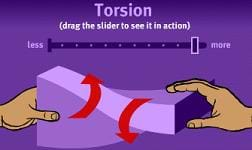Quick Look
Grade Level: 7 (6-8)
Time Required: 15 minutes
Expendable Cost/Group: US $0.25
Group Size: 2
Activity Dependency: None
Subject Areas: Physical Science

Summary
Students use hot glue gun sticks to learn about the forces of tension, compression and torsion.Engineering Connection
Engineers consider the impact of forces when designing and creating structures.
Learning Objectives
Students demonstrate their knowledge of compression, tension and torsion by conducting the experiment and successfully answering follow-up questions.
Educational Standards
Each TeachEngineering lesson or activity is correlated to one or more K-12 science,
technology, engineering or math (STEM) educational standards.
All 100,000+ K-12 STEM standards covered in TeachEngineering are collected, maintained and packaged by the Achievement Standards Network (ASN),
a project of D2L (www.achievementstandards.org).
In the ASN, standards are hierarchically structured: first by source; e.g., by state; within source by type; e.g., science or mathematics;
within type by subtype, then by grade, etc.
Each TeachEngineering lesson or activity is correlated to one or more K-12 science, technology, engineering or math (STEM) educational standards.
All 100,000+ K-12 STEM standards covered in TeachEngineering are collected, maintained and packaged by the Achievement Standards Network (ASN), a project of D2L (www.achievementstandards.org).
In the ASN, standards are hierarchically structured: first by source; e.g., by state; within source by type; e.g., science or mathematics; within type by subtype, then by grade, etc.
International Technology and Engineering Educators Association - Technology
-
Refine design solutions to address criteria and constraints.
(Grades
6 -
8)
More Details
Do you agree with this alignment?
State Standards
Massachusetts - Science
-
Explain how the forces of tension, compression, torsion, bending, and shear affect the performance of bridges.
(Grades
6 -
8)
More Details
Do you agree with this alignment?
Materials List
- glue sticks (the kind used in heated glue guns)
- rulers (for measuring)
- thin permanent markers (for marking on the glue sticks)
Introduction/Motivation
When structures are being built, engineers must be aware of the forces that will be acting on the structure --- so they can make appropriate design and materials decisions. In today's activity, we will investigate those forces and how they might affect a structural member (a glue stick).
Procedure
Have students follow the procedures below:
Glue stick experiment to show tension and compression created by bending.
- Use a ruler to mark four straight 4-inch lines that run the length of a glue stick. Space the lines 90-degrees apart: one on the top, one on the bottom, and one on each side of the glue stick.
- Holding a glue stick between a finger and thumb, apply a force to the middle and note how the lengths and shapes of the lines change.
Glue stick experiment to show torsion.
- Use a ruler to mark a series of straight lines along the length of a glue stick, as described in the previous experiment.
- Have pairs of students work together: Have one student hold one end of the glue stick, while his/her partner twists the other end as hard as possible.
Assessment
Assign the Investigating Questions as homework or a quiz. Or conduct a class discussion. (Refer to associated lesson for background information on forces.)
Investigating Questions
- What happens to the line on the top of the glue stick (the side where your finger pushes)? What happens to the line on the bottom?
- What happens to the lines on the two sides of the glue stick?
- What is tension? Compression?
- What happens to the lines on the glue stick when it is twisted?
- Imagine that each vertical line represents a line of glue molecules. Notice how they have been slid sideways out of position by the twisting movement. This is the sign of shear forces acting inside the material.
- Can you explain shear force?
- What is torsion?
Subscribe
Get the inside scoop on all things TeachEngineering such as new site features, curriculum updates, video releases, and more by signing up for our newsletter!More Curriculum Like This

Students are introduced to the five fundamental loads: compression, tension, shear, bending and torsion. They learn about the different kinds of stress each force exerts on objects.

Learn the basics of the analysis of forces engineers perform at the truss joints to calculate the strength of a truss bridge known as the “method of joints.” Find the tensions and compressions to solve systems of linear equations where the size depends on the number of elements and nodes in the trus...
References
Forces Lab. Building Big. PBS. http://www.pbs.org/wgbh/buildingbig/lab/forces.html
Copyright
© 2013 by Regents of the University of Colorado; original © 2005 Worcester Polytechnic InstituteSupporting Program
K-12 Outreach Office, Worcester Polytechnic InstituteLast modified: February 17, 2018







User Comments & Tips